Jane Lindskold's Blog, page 119
September 9, 2015
The Cost — Grand Finale
I’m just in from the National Book Festival and staying on for a few days to visit friends and family in Washington, D.C.. Still processing the event, so I’ll tell you about it next time. Promise!
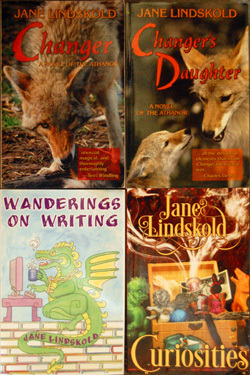
My Books, By Obsidian Tiger Press
For the last several weeks, I’ve been answering a rather complex question asked by Louis Robinson. For those of you who are just “tuning in,” you might want to read “The Cost” Part One and Part Two.
For ease of reference, I’m going to repeat Louis’ original question here: “Well, my immediate reaction was to wonder how much we’d have to raise on Kickstarter to pay you to write the 4th Breaking the Wall [hmmm… should I maybe be taking that series title literally, or at least more so than I have so far?] book. And no, you don’t need to answer that, or even think about the answer. But it did lead me to something that might be answerable: what does it cost you to produce a new book – in terms of time, of resources, of blood, sweat, toil and tears? And how do you judge that you’ve been fairly recompensed for your labour?”
Last week, in our journey into the creation of a book, I’d reached the point where I’ve written the book, self-edited it, solicited editorial input from at least one other reader, and maybe even hired a professional editor. When all of that was done, I had it copyedited.
Now I’m going to take us to the point where I’ve sat down with the copyeditor’s comments and made suggested changes, all the while wincing at my inability to be consistent. Now that I have a finished manuscript that’s as good as I can make it, the time has come to get it set up in book form.
If I were working with a professional publishing house, this would be their job. I might get an occasional query along the way but, basically, until I’m sent final proofs to review, I’m out of the picture, free to go on with my life or with other projects.
However, when self-publishing, this is the beginning of what – for me, given my skills and my temperament – is perhaps the biggest time for “blood, sweat, toil and tears.”
The final phrase above is a perfect example. I’m quoting Louis, so I’m preserving his punctuation. However, as an advocate of serial commas, the lack of a comma after “toil” makes me nuts. Nonetheless, serial commas or no serial commas will be the least of the decisions facing me.
I have some small experience with self-publishing. My first effort was bringing out reprints of Changer and Changer’s Daughter (aka Legends Walking), because the fans kept asking me for them and because it was becoming increasingly apparent that no one else was going to do it for me. My second effort was this past year, with the creation of Wanderings on Writing (a non-fiction book on writing) and Curiosities (my new short story collection).
In none of these cases did I do the conversion of manuscript into e-book and POD myself. I don’t have the skills nor the equipment and felt, quite wisely, that it was worth paying out some of my own money to buy someone else’s skills. In neither case was I over-charged. However, once again (as with hiring an editor and copyeditor), this was an expense that I would not incur when working with a professional publisher. In fact, they would be paying me for the privilege of spending their own money to bring out my book.
I know there are inexpensive and even free programs for doing conversions. Fine. If you want to take that course, by all means, do so and my blessings on you. However, I’m answering Louis’ question about what I would do and hiring a formatter would be the next step.
So, I hire a formatter. The formatter does her wizardry. I have a book ready to upload, right?
“Right” only if you’re doing a sloppy, amateur job. I’m not going to name names, but one of the most outspoken early advocates of self-publishing as a way for professionals to either bring out their backlist or to get more new work to their readers without the delays caused by those tyrannical publishers did just this. Said person (I’m avoiding even pronouns, so guess all you want) put out books full of errors in spacing, stray punctuation, and even hold-over redlines from editing programs. A friend of mine who had been happily buying this person’s work gave up in disgust.
So the first step after the formatter has done her wizardry is proofing… Yes. Again. And this won’t be the last time.
Here’s where self-publishing becomes either interesting or maddening, depending on your temperament. There are many little details that the production department of a professional publishing house handles for the author. These include choice of font; choice of dingbats; initial caps for chapters or sections; whether to use initial caps at all or only for chapter starts or for every new section; whether to ornament the chapter headings; how to ornament the chapter headings… I’m sure I’m forgetting some, but you get the idea.
This is called “book design” and it involves both artistic ability and an awareness of the traditions of publishing. A skilled book design team has done so many books that they have this by heart. I don’t. The first time I did a book, the formatter said something like, “Hey, I see you have asterisk breaks in the text. I looked at the original novel and they used dingbats there. Do you want dingbats? If so, pick some out. Here’s a website.”
Said website had literally thousands upon thousands of dingbats. I felt dingbats were important, but I curled up into a ball from sensory overload and began to wail. The formatter took pity on me and sent a shorter list. (I was charged for her time in assembling this, as well I should have been, since I was using her skills.)
Wait… You don’t know what a dingbat is? No. It’s not an insult. Dingbat is a perfectly legitimate formatting term; it refers to those little squiggles or doohickeys or dots or whatevers that indicate a break in time or change of point of view within a chapter. Because, especially in a novel, I will often have multiple points of view in a chapter, a dingbat is crucial to provide a subliminal clue to the reader that the point of view has shifted from, say, Firekeeper to Derian.
Dingbats are as important to a novel as any other punctuation mark. In e-books, they’re becoming even more important because various reading devices permit changes of font, size, and spacing. Therefore, something “hard” to indicate breaks is essential if the authors wishes to maintain the flow of the text. In the days of “print only” books, a blank space could be enough to indicate a pause, but if the reader can eliminate spaces, then something else needs to do the job. For Changer and Changer’s Daughter, we ended up selecting two different dingbats: one to indicate change of point of view or a long break in time; the other to go where a blank space would once have served.
My second formatting experience was somewhat different. Wanderings on Writing did not include dingbats, because I wanted to preserve the block paragraph pacing of the original blogs on which the essays were based. However, Curiosities was more traditional in form. When I received the first “go round” of proofs, the formatter had taken on the role of book designer (which is what her company promises) and had offered some suggestions as to initial caps and the like.
The problem was, once I started proofing the book for “form” rather than for content, I really didn’t like those initial caps. I felt they were too large, too “strong,” and that, rather than ornamenting the text, they overshadowed and distracted from it. The book designer – her name is Emily – was exceedingly patient with me. We reviewed various options, chose the shading, then designed complimentary chapter headings, flourishes, and dingbats.
We did this more than once. I’d have a meeting with Emily. She’d go back to her office and make changes. And then I’d proof the whole thing again. I think I proofed Curiosities at least three times after it went into production. That doesn’t count all the times I proofed it before, or that Jim proofed it, or that my friend Paul proofed it.
The fact is, every time you make a change in the formatting of a book, you really should proof it again for how the book “looks,” not for content. You’re looking for stray words, widows and orphans (look it up), overlapping text, weird blank spaces, and a bunch of other purely “gut” things that make the difference between a professional-looking job and a “I slammed it through the meat grinder.”
(“Meat grinder” is also a technical term… I’m not being obnoxious.)
Somewhere along the way, you also need to consider cover art and cover design. Again, I have absolutely no artistic sense or talent, so this is something I need to hire someone to do for me. For Changer and Changer’s Daughter, I used photo art, which was pretty common at the time. For Wanderings on Writing, my friend, Tori Hansen painted a quirky water color that fit the mood I wanted to project. For Curiosities, Rowan Derrick provided a very elaborate photo manipulation that, again, was tailored to the concept of a story collection.
If I were to produce a new novel in a series, my first impulse would be to at least query the original series artist. However, I suspect major professional artist’s work might be a lot more than I could afford (unless the Kickstarter included a whopping sum just for cover art). Therefore, I’d need to find other options. With the bar for even self-published book covers constantly raising higher, I’d need to set aside both money and time to work with the artist.
Even after the art was chosen, there would be the cover design which, once again, is a job that takes skills I lack. Emily worked with me on cover design for both Wanderings on Writing and Curiosities, but I was there, too, spending my time and effort.
In fact, in all the stages of production, I served as assistant… Which takes time, energy, thought, and (because for many of these jobs I needed to learn an entirely new vocabulary) stress.
But once it’s over, I’d have a complete book. I’d get it loaded on as both e-book (differently formatted for several markets) and POD (because some people, including me, still prefer paper books).
Time to relax and celebrate? Oh, no… The work is just beginning. There’s the question of advertising. Of getting involved with blog tours and other ways to let people know the book exists. That means trying to solicit reviews, not just from readers, but from the professional venues that tend to sneer at self-published work.
Oh… And if one did do a Kickstarter campaign, this is the time when you need to make good on your promises and send packages and e-mails and all of that stuff to the kind subscribers. It’s very exciting when you have hundreds of subscribers, less so when doing hundreds of packages.
I’m a writer. I’m really good at writing. I’m very attentive to self-editing. Anything beyond that falls into the category of blood, sweat, toil, and tears…
So, Louis, it would be very hard for me to put a dollar amount on what it would cost for me to do this. All I know is that, no matter what people will try to tell you, producing a book is neither fast or easy, not, at least, if you’re me and you insist on doing the best job you can.
I’d be willing but, especially when taking on writing a new book in an existing series, I’d need reassurance that there really was an audience for it before giving up a solid chunk of my life to producing it.
Any questions? Comments?


September 4, 2015
FF: Amusing and New
Between Bubonicon and getting ready for the National Book Festival this weekend, my reading time was severely truncated. As far as I am concerned, the only good thing about the fact that I’m going to spend a couple of days on airplanes and stuck in airports is that I’ll have lots of time to read.

Finding Time to Read Was a Balancing Act
For those of you new to this post… The Friday Fragments lists what I’ve read over the past week. Most of the time I don’t include details of either short fiction (unless part of a book length collection) or magazine articles.
The Fragments are not meant to be a recommendation list. If you’re interested in a not-at-all-inclusive recommendation list, you can look on my website under Neat Stuff.
Once again, this is not a book review column. It’s just a list with, maybe, a bit of descriptions or a few opinions tossed in.
Recently Completed:
The Strange Case of Origami Yoda by Tom Angleberger. Tommy, a sixth grader, tries to figure out the secret of Origami Yoda. Written journal style, which I am a sucker for when it’s done well… I decided to try this because I may meet Mr. Angleberger next week since we’re both guests of the National Book Festival. See below…
The Secret of the Fortune Wookiee by Tom Angleberger. I seem to have missed one in the middle, but Mr. Angleberger provides enough transition that I easily picked up with this one. Dwight is mostly off-stage in this one. The “Secret” proves amusing.
In Progress:
The School for Good and Evil by Soman Chainani. Audiobook. So far no surprises. Good descriptions.
The Books of Great Alta by Jane Yolen (aka a compilation volume of her Sister Light, Sister Dark and White Jenna. Just started.
Also:
Did I mention that the only good thing about two days spent travelling is that I get to read?


September 3, 2015
TT: Artemis Examined
JANE: I’ve spent the last week being alternately nervous and excited while I anticipated/dreaded what you’d want to say about my “Artemis Awakening” books. Let’s go for it!
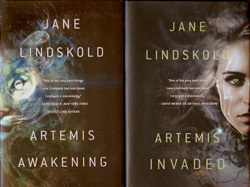
The “Artemis Awakening” suite
ALAN: The first thing that struck me about Artemis was just how well the history of the place was integrated into the story. The characters on the page are well aware that they are living at the end of a long span of time during which many complex things have happened, things that have shaped their own culture. We catch glimpses of this history as it pertains to the story that is being told, but there is obviously a lot more that we are not being told.
So how much work did you put into the backstory before you first set pen to paper?
JANE: I put in a fair amount of work, but less on a reasoned out “backstory” than on what sort of culture would have created Artemis and her inhabitants. So I don’t have an equivalent to the “Annals of Kings and Rulers” or whatever it was Tolkien put together, but I do have a very strong sense of the seegnur culture, both as it was at its prime and as it began to break down.
The “whys” tend to fascinate me more than the nuts and bolt “hows,” and nuts and bolts interest me very little as such, which is why I took the seegnur’s technological developments in the direction I did – with technology tied to psionics, rather than circuit boards.
ALAN: And along the way you came up with some quite novel concepts – I’m thinking here of Adara’s relationship with the puma Sand Shadow. There’s a two-way psionic bond, but there’s also a physical aspect to it. Both Adara and Sand Shadow have been genetically modified. Adara has “claws” and Sand Shadow has “hands.”
JANE: Adara has “cat’s eyes,” too… I thought the book cover for Artemis Invaded did those very well.
I’m not sure the concepts are “novel,” but certainly in the majority of print SF I’ve read, if they are used, they are presented as “negative mutations” or results from attempts to create super soldiers or something.
I want to stress print because humans with animal traits are more common in illustrated SF – and not only in the stuff for “kids,” either. The current graphic novel hit Saga does some brilliant work with blending human and animal characteristics.
Have you seen it?
ALAN: No, I haven’t – I don’t really understand graphic novels. Pictures don’t do anything very much for me and I have problems with the continuity between panels as well. So because I can’t read them, I don’t read them, if that isn’t an oxymoron…
JANE: Actually, that makes perfect sense. Going back to blending of human/animal traits in characters…
I guess I’m weird, but I’ve always thought such adaptations would be wonderful and exciting, so I decided that the seegnur who created Artemis would, too.
One thing I’d like to stress… The “demiurge” relationship goes both ways. This isn’t a “wizard and familiar” thing.
Sand Shadow is Adara’s demiurge, but Adara is Sand Shadow’s demiurge as well. In Artemis Invaded, they both are coming to terms with the fact that their relationship with the planet may be a variation on the demiurge relationship between humans and animals. Since there are indications that the relationship has physical, as well as mental, ramifications, this could be very interesting indeed.
ALAN: Oh indeed – that comes across very clearly.
JANE: Going back to the first part of your comment – that Adara and Sand Shadow have a psionic bond (as do Bruin and Honeychild, for that matter)…
Communication in general fascinates me. I mean, you and I started these Tangents because we found it interesting how we both spoke English but often couldn’t understand each other! Just the other day, you asked me to explain what “dog kibble” was…
ALAN: “Two nations separated by a common language” as somebody once said. And kibble is such a very weird word…
JANE: Anyhow, since in the Firekeeper novels, I’d already “done” human/animal communication based around the idea that animals have language of sorts that humans can learn to speak, I wanted to do something different with the communication between humans and animals on Artemis. Since I already planned to use psionics, that was the natural route to take.
However, I also try to make clear that this isn’t an instant “fix.” Adara and Sand Shadow are still working on building their own image-based language – one that bridges the differences in their sensory apparatus, life-experiences, and such.
ALAN: And you also explore that same idea from the other side, as it were, when you show us the gradually evolving communication that Adara and Sand Shadow have with Artemis herself.
Indeed, the whole structure of the story depends on (not always successful) communications of one sort and another. For example, vital plot points depend on decoding Ring’s often incoherent sentences, which are caused by the confusion of the ever-shifting probabilities that he sees as all the futures shift around him.
Was this thematic choice a conscious decision or did it just arise by itself from the narrative structure?
JANE: It rose from the narrative structure… I rarely impose a structure on a story. I let the story make up its own mind. By the way, I love Ring! I’m so glad you mentioned him. My own Oracle of Delphi.
ALAN: Yes, he did seem somewhat oracular! In fact, you refer to a lot of Greek myths in the books, particularly with the naming of names. We’ve already met Artemis and Leto (and I kept looking for Artemis’ brother Apollo, but I haven’t found him yet). And Castor and Pollux appear as well, of course. Why did you do this?
JANE: I wish we were doing this in person on a panel, because if we were, you could see I’m bouncing up and down on my chair…
I really wanted to call the planet Artemis, but I had to wonder… Would the Greek myths survive that far into the future? I mean, back when I was teaching college, most of my students didn’t know who Apollo was, much less Artemis or Leto.
(Small aside: I bet Rick Riordan’s popular mythology-based novels will help mend that gap for the current generation!)
So I considered and decided that in some contexts the Greek mythological figures would indeed be remembered – and one of the reasons would be because planets and other astronomical features keep getting named for them. This, in turn, would mean that variations of the myths would be included in Wikipedia and its descendants into the future.
Castor and Pollux are named more for the constellation than for the warriors of myth.
Griffin is named for a “historical” figure, not for the winged eagle/lion hybrid monster.
Such little touches of world-building actually get me very jazzed.
ALAN: And that’s why it feels so real. The devil is in the details and you’ve obviously put a lot of thought into those details; right down to the individual words themselves. Where did “seegnur” come from?
JANE: “Seegnur” comes from the Latin “seniorem,” which is the root for the English “senior.” It’s the root for the Italian “signore” and the French “seigneur,” both of which originally meant “lord.” It also survives in the French “monsieur,” and Church title “monsignor,” both of which basically mean “my lord.”
Why is this important? I wanted to use a word that wasn’t English but that would have “echoes” to the ear of an English speaker.
It’s pronounced “seeg-nur.”
ALAN: And by putting all these things together, you really have managed to create that sense of wonder that is so important to a well-told science fiction story.
So we come full circle. When we first started talking about this topic, I never realised that we’d have so much to say about it. Amazing, eh?
JANE: Uh… Can I get away with saying “wonder”-ful?
ALAN: Of course you can. But only once…


September 2, 2015
The Cost — Part Two
Bubonicon was lots of fun this past weekend. I’m still defragging from being around so many people. And on Friday I leave for the National Book Festival in Washington, D.C. I’m sure it will be fun… At least once the travel part is over! Anyhow…
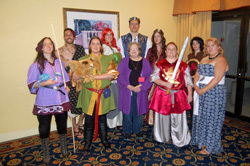
Tortallians and Tamora Pierce
A few weeks ago, I asked Wanderings readers to suggest topics they’d like me to talk about. (Hint! I’m still open to questions. I really like writing about topics I know you’re interested in hearing about.)
Louis asked a very complicated question. Last week I set out to answer part of it. This week I’m continuing on.
If you haven’t read my previous post on this topic, you might want to take a look at “The Cost: Part One.”
I’m going to repeat Louis’ question in full, because the context is important: “Well, my immediate reaction was to wonder how much we’d have to raise on Kickstarter to pay you to write the 4th Breaking the Wall [hmmm… should I maybe be taking that series title literally, or at least more so than I have so far?] book. And no, you don’t need to answer that, or even think about the answer. But it did lead me to something that might be answerable: what does it cost you to produce a new book – in terms of time, of resources, of blood, sweat, toil and tears? And how do you judge that you’ve been fairly recompensed for your labour?”
Last week I talked about the time it would take to write such a book, and also touched on the question of length. Now to talk about the actual writing and some of what happens once a manuscript is complete.
Ever since writing became my full-time job, I treat it like one. That includes allowing myself weekends and evenings off. If this sounds overly liberal, please remind yourself that I don’t get any paid vacation or holidays. Also, I often end up working on weekends, whether responding to e-mails and keeping an eye on social media, participating in book events, or doing research.
And I’m usually at my desk by 8:00 in the morning, often by 6:30, so while I may be self-employed, I don’t think I qualify as a slacker.
My writing “pulse points” vary depending on where I am in a book. I’m slower at the start, faster toward the end. An interruption in composition (for example to deal with another project) will slow me down until I get back into the writing. Basically, I’m neither slow nor fast, but I am steady. What I write in my first draft tends to be of good, but not perfect, quality.
I’ve talked a lot about various aspects of how I write in these Wanderings. You can look at the other posts to get a feel for how I go about things (see the “Writing” category). Or, for a slightly more organized and focused look at the topic, I recommend my recent book Wanderings on Writing.
So, let’s assume I’ve spent a good chunk of the previous year immersed in writing a 150,000 word novel. As I said, what I write in that first draft tends to be of good, but not perfect, quality. I am, however, a perfectionist, so my next job is going through the manuscript, looking for where I put notes to myself (I mark these with square brackets, because that makes for a fast search), and addressing any questions or incomplete material. In the process of doing this, I usually re-read the manuscript off the screen, tightening as I go. As I said earlier, despite the length of my books, I don’t write “fat.”
When that on-screen read-through is complete, I print a copy of the manuscript and settle in to read it all over again, this time with a red pencil in hand. Again, my goal is to make the novel as tight, clear, and vivid as possible.
How long does this take? Weeks for each read-through. The amount of time needed for that first “off the screen” read will vary, depending on how many bracketed comments I need to address and how complex the questions I’ve asked myself are. The second read-through is deliberately slow, because my goal is to read carefully and I’m fighting an urge to rush. After this, it’s data entry time as I make numerous small changes.
Only when I’ve gone through the manuscript at least twice and made it as perfect as I can, does patient Jim get to see what has been obsessing me for the better part of the last year. He reads through with pencil in hand. Based on the number of typos, missed words, and suchlike he catches, he provides evidence for the frequent assertion that authors cannot proof themselves because they know what they wrote, rather than seeing what was actually written.
How long does Jim’s read-through take? This depends on his schedule, but I usually try to allow at least a month in my time allocation toward making a deadline because he has a full-time job and is reading during his commute or maybe a bit on the weekends. Oh… I consider his erratic reading schedule an advantage. That’s just how most “real” readers read a book, at scattered moments, not in a sitting or two (as do many editors). If Jim says, “I’d forgotten that…” or something similar, and I hadn’t intended for that element to be overlooked until the proper moment, I know I have work to do.
Then, after Jim is finished, I’m back to data entry, making his suggested corrections or, occasionally, making a note of a comment that I don’t agree with but that I want to remember in case I hear it from another reader. Sometimes, at this point, either a friend will offer to read the manuscript and offer comments, or (maybe because of something Jim brought up) I’ll solicit more feedback.
These numerous read-throughs are just the beginning of what I might term the blood, sweat, toil, and tears phase of a book. However, even at the times when I rely on a traditional publisher, they are far from the last.
I’ve written elsewhere about the value of a professional editor, so I won’t go into that again except to say that if I were to self-publish a novel, I’d want to do my best to find someone to do that job. This doesn’t come cheap, not if you want someone who is good. If I was trying to get a novel in a series edited, I’d need to find someone who was either familiar with the original books or was willing to read the previous books…
So a professional editor is a “cost” element, too.
Oh… And a professional editor is also a “time” element. This goes back to my comment in the prior essay about “handing in to my editor.” More often than not, a writer meets his or her deadline, then settles in to chew his or her nails while waiting for a response. After all, unless you’re very lucky or a bestie-bestseller, you are not your editor’s only concern. I’ve had slow editors and fast editors. Speed had absolutely nothing to do with quality. Some slow ones sucked. Some fast ones were brilliant. And vice versa.
If you’re going to work with a professional editor, in addition to budgeting money to pay the bill, you’d better budget time. If the book is coming out “whenever,” that’s okay, but if you’ve promised those folks on Kickstarter you’ll have it out by Christmas or you want to catch the summer “beach book” crowd or whatever, then this can be acid stomach time if you didn’t budget for a delay at this point.
Even if I was willing to do without a professional editor, which I just maybe might be willing to do for a novel in a series, since I’m likely to be more familiar with the foundation material than anyone I could hire, I wouldn’t do without a copyeditor.
What’s a copyeditor? A copyeditor is someone skilled in proofreading a text not only for typos and suchlike, but for inconsistencies (whether of content or spelling and format). A copyeditor also knows all the rules for punctuation. Yes. There are always disagreements regarding as to when a certain piece of punctuation should be used. However, most publishing houses have a “house” style they use. For many, this is the Chicago Manual of Style. This will be the default unless the author expresses a strong desire for an alternate.
In these cases, the copyeditor’s job also includes making and maintaining a list of these oddities. For example, I always spell the color “gray” (to Americans) as “grey.” This is because my brother is named “Graydon,” usually shortened to “Gray” and so, even as a relatively small child, my brain categorized “gray” as a name and “grey” as a color.
A good copyeditor is worth bouquets of flowers and boxes of chocolate (or bottles of whisky and bags of coffee). A poor copyeditor is a nightmare beyond knowing… Authors sit around and tell stories about bad copyeditors the way normal people tell ghost stories. Really!
If you want to know more about copyediting, I highly recommend Teresa Nielsen Hayden’s excellent essay, “On Copyediting.” You can find it in her collection Making Book. In addition to talking about copyediting in a general sense, she includes a bunch of material specific to SF/F, which cannot be praised enough as a means toward avoiding dumb mistakes.
Since my punctuation can become, uh, idiosyncratic, especially when I’m typing fast, and because (as noted above) a writer really cannot proof herself, I would need a professional quality copy editor. These do not come cheap. And they do not work fast, so here’s another investment in both money and time.
And the “expenses” involved in producing a book don’t end here, especially if you’re self-publishing… However, I’ll save the next phase for next week!


August 28, 2015
FF: Short List!
Remember! Bubonicon starts this evening. I’m seriously considering reading some of my earliest short stories as a way of celebrating the impending release of Curiosities, my forthcoming short story collection. Getting the book ready has taken a lot of my reading time this week, but I did still manage.

Sirenity Contemplates the Blind Detective
For those of you new to this post… The Friday Fragments lists what I’ve read over the past week. Most of the time I don’t include details of either short fiction (unless part of a book length collection) or magazine articles.
The Fragments are not meant to be a recommendation list. If you’re interested in a not-at-all-inclusive recommendation list, you can look on my website under Neat Stuff.
Once again, this is not a book review column. It’s just a list with, maybe, a few opinions tossed in.
Recently Completed:
Max Carrados mysteries by Ernest Bramah. Max is blind, although almost supernatural in his “sightedness.” Some of the stories are a bit contrived but I found Max an appealing character. Don’t read unless you like “old-fashioned” mysteries where most of the action occurs off-stage.
The Strange Case of Origami Yoda by Tom Angleberger. Tommy, a sixth grader, tries to figure out the secret of Origami Yoda. Written journal style, which I am a sucker for when it’s done well… I decided to try this because I may meet Mr. Angleberger next week since we’re both guests of the National Book Festival.
In Progress:
Omnitopia Dawn by Diane Duane. Audiobook. Having liked some of her YA/middle grade fantasies, I decided to try this.
Also:
Lots of shorter stuff and work-related stuff and, as mentioned above, going over (and over) proofs of Curiosities as we tinkering with flourishes.


August 27, 2015
TT: Modern SF — Lacking Sense of Wonder?
JANE: Last time you commented that all the works we’d been discussing were “older.” My immediate response was that Varley wasn’t “older.” Then I realized we were discussing books from late-1979 and the early 1980’s. Time has slipped by…

Wonder Is Where You Find It
I was going to mention Larry Niven, but the titles I’d mention would be from his older work…
So, we definitely DO need to look at more current SF… You write a review column, so you probably keep more on top of new releases than I do. What’s your reaction?
ALAN: I’ve almost given up reading SF. I find many modern writers to be mostly concerned with the surface of their story, and often there is very little depth. More time is spent on spectacle than it is on ideas, and much of it appears shallow to me.
Of course, you could say I am just jaded, a crusty old curmudgeon who claims that “They don’t write ’em like that anymore,” and probably there’s a certain amount of truth in that.
But the Panshins spend several hundred pages of their book (The World Beyond the Hill ) exploring the thesis that the best science fiction is a lot more than just spectacle and they give many so many concrete examples from the SF of the past, that I think my position is not entirely untenable.
JANE: Oh! I agree. I’ll also admit that I dropped out of reading much SF for quite a while.
Are there any modern authors that you think do manage to turn on your sense of wonder?
ALAN: Yes – there are some. Stephen Baxter is a very good writer indeed. Sometimes his enthusiasms run away with him and he lapses into incoherence. But when he’s firing on all cylinders there’s nobody to touch him.
I’m particularly fond of The Time Ships which is an authorised sequel to H. G. Wells’ The Time Machine.
He’s also not afraid to paint on a large canvas. His Xeelee sequence begins in the present day and ends when the Milky Way galaxy collides with Andromeda five billion years later. During this timeline, humanity evolves to become the second most powerful race in the universe, next to the Xeelee themselves. The stories concentrate far more on big ideas than they do on character development, so they do tend to be rather cold and distant.
But he can do people well when he wants to. The four novels that make up the Time’s Tapestry series concern themselves with interventions into our past from a (possibly) alternate-history future. As well as concerning themselves with the grand scope of the theme, the stories also pay a lot of attention to the impact of this meddling on the very real lives of some very real people. As a result, I think these novels are my favourites of his work – though I retain a soft spot for the stand alone novel Evolution which follows the evolution of humanity from the distant past to the far future. In this book Baxter does for people what James Michener did for places. It’s a clever conceit and I loved it!
JANE: Sounds impressive – and a bit intimidating, I’ll admit!
I’ll put in a vote for Vernor Vinge, especially Fire Upon the Deep and Deepness in the Sky, although I have a fancy for the Earth-based Rainbow’s End as well.
Although Vernor (I use his first name not only because I know him, but because his ex-wife Joan also writes SF as “Vinge.”) has become something of a demi-god among the computer geek set, it wasn’t his use of the Singularity that caught me, it was his aliens.
Both the canine group-mind Tines (Fire Upon the Deep) and the “Spiders” in A Deepness in the Sky are far more than humans in costume. They are well-realized and complex, from their biology on up. (This is something that I feel is done too rarely with aliens. Larry Niven did it well with the Kzinti, Trinocs, Puppeteers, and other inhabitants of “Known Space.)
Vernor’s aliens are different on many levels (physical, social, cultural) from the humans they encounter, which leads to some very natural misunderstandings and – as in the best “sense of wonder” writing – left me “wondering” about the assumptions we tend to make about the ways intelligence will develop.
But even if it was the aliens who grabbed hold of me, I’d be remiss if I didn’t mention that Vernor’s future humans have – for me – just the right mix of familiarity and difference to make them “futuristic” in the best sense, not twentieth (or twenty-first) century humans with cooler tech.
Your turn!
ALAN: I’m very fond of Kage Baker as well – her time travel/cyborg novels about the Company are inspired and inspirational. Tragically, she died far too young, but the novels that she left behind are wonderful.
An organization called Dr. Zeus operates from the 24th century, using technologies of time travel and immortality to exploit the past for commercial gain. The immortality technology works by turning young children recruited in the deep past into cyborgs who, once they reach maturity, will never die. Time travel itself is very limited. It only allows journeys into the past, and a return to the present. But the employees of Dr. Zeus, who were recruited in the past, live through the ages, travelling slowly into the future at the rate of one second per second. They are instructed, as time and opportunity present themselves to retrieve and hide valuable artefacts that have been lost to mainstream history in accidents and catastrophes, and then to “rediscover” them in the future. And so Dr. Zeus itself becomes obscenely rich and influential.
But as the series progresses, it becomes increasingly clear that the Dr. Zeus story is itself a fiction and the Company’s ostensible purpose is mere window-dressing. Something much deeper, much more fundamental, is taking place. The final revelation is quite jaw dropping – and along the way we get a lot of brilliantly conceived and complex books.
JANE: I’ve been meaning to read her stuff since you first mentioned it to me some years ago. I’m going to need to make a more serious effort.
ALAN: And Jack McDevitt’s books are always worth reading as well, of course – after all it was a discussion of his books that led us into this subject in the first place!
You are pretty good at it too. Your Artemis novels gave me an authentic spine-tingle.
JANE: Thanks! I was hoping to achieve “wonder,” not just cool FX. Would it be presumptuous of me to ask what made the “Artemis Awakening” books work for you on the “wonder” level?
ALAN: Actually that’s quite a large topic. Perhaps we could talk about it next time?
JANE: Okay… But I have stage fright!


August 26, 2015
The Cost — Part One
News Flash! Bubonicon is this coming weekend. Theme is Women of Wonder. Guests of Honor include Tamora Pierce, Catherynne M. Valente, Mary Robinette Kowal, and Ruth Sanderson. I’ll be there all three days, and hope to see many of you!
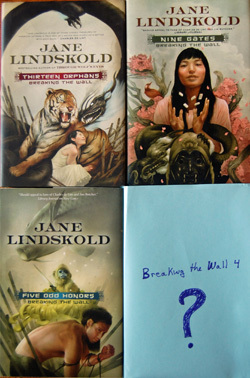
One, Two, Three, More?
Last week I solicited questions from Wednesday Wanderings readers. This week, I’m going to tackle at least some of Louis’ very complex ones. And, yes, I’m still interested in hearing from you about what you’d like me to talk about! Either put your suggestion in the Comments or e-mail me at jane2@janelindskold.com.
For ease of reference, here’s what Louis said: “Well, my immediate reaction was to wonder how much we’d have to raise on Kickstarter to pay you to write the 4th Breaking the Wall [hmmm… should I maybe be taking that series title literally, or at least more so than I have so far?] book. And no, you don’t need to answer that, or even think about the answer. But it did lead me to something that might be answerable: what does it cost you to produce a new book – in terms of time, of resources, of blood, sweat, toil and tears? And how do you judge that you’ve been fairly recompensed for your labour?
Probably not the same answers every time, of course.”
Let me start with Louis’ “answerable” question. Then, I’ll see if I can touch on the rest. Some of this will inevitably repeat what I’ve said elsewhere, but I think it has value in a new context.
Also, Louis is absolutely right that the answer isn’t the same every time, but I’ll try to make my answer broad enough to give you a sense of how different situations will change my assumed “cost.”
In the past, I have budgeted a year to write a novel from start to finish, that is, to create a manuscript ready to hand in to my editor. Please note that last bit… I’ll be coming back to it. However, this “a year” is a deceptive statistic.
“Idea” is the most difficult element to which to assign an assessment of “time.” In all cases, I don’t start a novel until I have a clear idea of what I want to write about, so in that sense, it’s a non-element. Or is it? In a very real sense, I may have spent years, even a lifetime, coming up with that idea. One reason I read widely and eclectically is to “feed the Muse” for future ideas.
Even if I have a solid “idea,” still I need to lay some foundations in setting (which may include world building), character (ditto, since characters do not exist in isolation from their setting), and some of the bones of plot.
A new novel in a series presents an additional challenge – that of keeping the material consistent with what was presented in previous books.
I know several authors of highly popular, multi-volume series who actually rely on assistants (either paid or volunteer) to help keep track of the details in their increasingly complex series. The author is focused on the newest project, not all the small elements from earlier ones.
I don’t have such an assistant, so, if I were going to write another book in an on-going series, I would need to re-read all the previous books first: not casually, as one does when revisiting an “old friend,” but with razor-sharp attention to detail. I suspect the need to do this is a reason that, when some authors have picked up with pervious series after a long time lag, the new books take place in the next generation or at least after a suitable lapse of time so that mistakes in characterization or setting can be passed off to the passage of time.
I know that as a reader I’ve usually been disappointed by Whatever The Next Generation books… If I’m reading in a series, I want to rejoin my fictional friends and learn how what happened in prior books might influence their lives. Based on the questions I’ve received from readers of my various series, I suspect that’s what they would want from a new book in a series – especially if they’ve remained interested in the series over the years it has been on hiatus – so taking that time to re-read would be essential.
Therefore, even before I started writing, I would need time to re-read, take notes, and, most importantly, wrap myself in the “soul” of that place and those people. So, tack that onto the “year” to produce a book that you could read.
Let’s pause here to address the question of length of a book. Since Louis used a fourth “Breaking the Wall” book for his example, I’ll start with that. Each of the “Breaking the Wall” novels ran between 650 and just under 700 pages. I can’t give you a precise word count, because I don’t currently have complete manuscripts in electronic form, but let’s estimate 150,000 words.
(Oh… And compared to the Firekeeper novels, these were “short.” Most of those ran at least 200,000 words.)
I’m assuming that a reader would like a new book in a series to be about the same length as the previous ones in the series, offering the same level of complexity of characters and plot. As was shown by my experience with writing the “Artemis Awakening” novels (which the editor insisted be not much over 100,000 words), when I write a shorter novel, I can’t provide as much story. This is because I never write “fat.” I always try to make every word, every scene, count, often double.
Since Louis asked about “cost,” this is a good place to mention that the longer the novel, the more expensive it is to produce. Yes. This is true even with e-books, since the distributors charge according to the size of the file.
(And before you ask, “But do you need to bother with the distributors?” the answer seems to be “Yes.” In all the years I have been selling e-books via my website bookstore, I have had fewer than ten direct purchase requests. Almost all of these have been from “foreign” markets, where, for one reason or another, the reader has difficulty accessing marketplaces like Amazon.com.)
The cost element becomes an even more serious element with print-on-demand books, since the cost for these is based on size, yet book buyers (who don’t balk at buying groceries by the pound) want to pay roughly the same amount per book, no matter the size. Major publishing houses manage to keep prices in the same general range by offsetting projects against each other, but for a one-author operation, this isn’t an option.
Surely you’ve noticed that those bright-eyed self-published authors you encounter in increasingly large numbers at conventions almost always have very slim books? Cost is one of the reasons. Another is the awareness that they’ll make more money from several short books than from one long complex book. This is one of the reasons that, after nearly going extinct, serials are becoming popular once more. They’re a way to write short, sell more often, and yet tell a more complex story.
So, right off, my contemplated 150,000-word original novel is a bad idea in the self-publishing world… But let’s say I’m going to go ahead with it, maybe because that Kickstarter campaign Louis mentioned has shown me there’s an audience. What else goes into the project?
This seems like a good time to stop (since I need to do various things to get ready for Bubonicon this weekend and the National Book Festival the following weekend) but I’ll pick up the rest of the complexities of producing a book next time.
Meantime, remember that I welcome your questions!


August 21, 2015
FF: No Particular Theme
The Friday Fragments lists what I’ve read over the past week. Most of the time I don’t include details of either short fiction (unless part of a book length collection) or magazine articles.

Persephone, Before She Could Read
The Fragments are not meant to be a recommendation list. If you’re interested in a not-at-all-inclusive recommendation list, you can look on my website under Neat Stuff.
Once again, this is not a book review column. It’s just a list with, maybe, a few opinions tossed in.
Recently Completed:
Plain Tales from the Hills by Rudyard Kipling. Audiobook. Short stories, presented as factual reports, focusing on entanglements, romantic and otherwise in British India. Two at least provide further details of characters who appear in Kipling’s novel, Kim. I enjoyed.
Sammy Keyes and the Hollywood Mummy by Wendelin Van Draanen. Do an adult’s dreams need to vanish when she has kids? Sammy’s mom clearly doesn’t think so… But what is the cost?
Wicked Lovely by Melissa Marr. Audiobook. Ash sees faeries. This is not good, but it may be her salvation. Solidly in the growing sub-genre of “high school girl is loved by somebody supernatural.” However, unlike many of her fictional “sisters,” Ash has some problems with this.
In Progress:
Max Carrados mysteries by Ernest Bramah. Max is blind but almost supernatural in his “sightedness.”
Also:
500 Handmade Dolls: Modern Exploration of the Human Form edited by Valerie Van Arsdale Shrader. Mostly pictures. Wide variety of interpretations made fascinating, maybe even inspirational.
Still reading a lot of short non-fiction.


August 20, 2015
TT: More Wonder!
JANE: Last week, I mentioned that despite all our chatter, I keep thinking of authors who awaken “Sense of Wonder” for me.
Two words: Roger Zelazny.
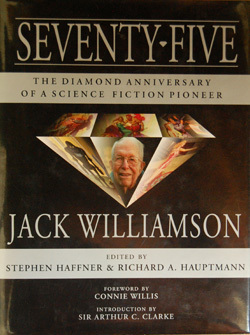
Jack Williamson Diamond Anniversary Collection
A couple of titles: Lord of Light, Creatures of Light and Darkness, This Immortal, Isle of the Dead, Eye of Cat…
But we spent a lot of time discussing Roger’s work a while back, so I’ll restrain myself from repeating. People who are interested can look Here and Here and even Here.
ALAN: Roger could certainly always give me that authentic spine-tingle. But he wasn’t alone in that. Theodore Sturgeon was also a master of the sense of wonder. His fix-up novel More than Human describes the evolution of homo gestalt, a combination of minds forming, albeit briefly, someone whose whole is greater than the sum of the parts. It has interesting things to say about morality and ethics, particularly in the last third or so of the book, which I must admit does get a tad preachy… But never mind.
JANE: (aside) “Fix-up,” for those of our readers who discovered SF prior to the dominance of the novel, is a novel constructed from various previously written short stories. Fix-ups can be especially good for “idea” stories, because the shorter length allows for focus on an idea, while combining them into a novel often provides more dimension to the characters.
Let’s see… Who else gives me that “sense of wonder” feeling?
For good old-fashioned adventure, you can’t beat Jack Williamson. I love Darker Than You Think, and his various “Legion of Space” stories. But he also touched a deeper cultural nerve in his tale “With Folded Hands,” (later re-done as The Humanoids), which introduces a future in which robot caregivers make everything wonderfully, absolutely, perfectly safe…
The setting and prose may be old-fashioned, but the more I look at our evolving “seat belt,” insurance-minded, sanitizer hand soap, never-take-a-risk culture, the more I think Jack was telling a parable for the ages. Today, so many sit “With Folded Hands.”
ALAN: Jack Williamson never really did much for me – I found his prose a bit clunky.
JANE: (Waving hand in the air in the best annoying student fashion.) Ooh!! Can I interrupt… Please?
ALAN: Are you asking for permission to take a toilet break? You aren’t? OK – what point do you want to make?
JANE: I’m not arguing that Jack’s prose could be less than artistic – but that doesn’t mean that he wasn’t a great contributor not only to SF’s ideas (something Arthur C. Clarke himself gave Jack credit for), but to its language.
Jack originated two terms that remain in current use and have, in fact, graduated from the realm of science fiction to general use.
“Terraforming” first appeared in his story “Collision Orbit,” published in Astounding Science Fiction.
“Genetic engineering” first was used in his 1952 novel, Dragon Island. It’s interesting to note that Williamson coined the term before the role of DNA in heredity was confirmed.
Jack didn’t coin the term “android,” but his use of it in “The Cometeers” in 1936 is credited with bringing it to a wider audience.
So, “clunky” or not, Jack Williamson contributed more to modern language than many of those self-consciously stylish prose writers.
ALAN: And in two fix-up novels, Seetee Shock and Seetee Ship, he coined the neologism “Seetee” which is a pronunciation of the initialism CT which itself stands for “contra-terrene” matter. These days we’d call it anti-matter (a concept first described by the physicist Paul Dirac in 1930). Williamson’s term never really caught on, but it should have. In my opinion, anti-matter is a rather ugly term. Seetee is much nicer.
So, yes, I cannot deny his importance in the field.
But equally, I cannot deny the importance of Henry James in the mainstream literary world. Nevertheless I cannot read anything by Henry James without immediately falling fast asleep.
JANE: Wow! Another place where our tastes cross! I am amazed.
ALAN: However, despite my feelings about Williamson, I did admire his collaborations with Frederik Pohl. But Pohl was, in my opinion, a genius. His Gateway stories have a sense of wonder in spades, particularly the first two novels which take place before the alien Heechee actually appear on stage, though evidence of them is everywhere around.
Does any of that help to pin down what I mean by sense of wonder?
JANE: It does. What did you think of John Varley’s three-part Titan, Wizard, Demon?
ALAN: I really enjoyed them, though I gather that a lot of people don’t think much of them. The alien Titanides are brought brilliantly to life and as the series progresses it gets more and more surreal. (I’ve always loved surrealism). The image of a fifty-foot tall Marilyn Monroe has stayed with me for many years…
JANE: I’m with you on enjoying them. (And a lot of people must have agreed with us, since Titan was on every major award ballot when it came out, then won the Locus Award in the novel category. The sequels also hit the award lists.)
The first novel Titan focuses on the initial exploration by the crew of the Ringmaster of a planet-sized intelligence dubbed Gaea. Gaea (who isn’t round like a planet, but is shaped like a Stanford torus) has been deeply influenced by exposure to television and movies that reached her via television signals. Various strange things happen to the crew before they meet Gaea herself.
Wizard is set several years later. The ship’s captain, Cirocco Jones, has become a full-time resident of the Gaea – her ambassador or resident “Wizard” and a raging alcoholic. Her friend, Gaby, another survivor of the Ringmaster’s crew, handles much of the day-to-day work, including interfacing with “pilgrims” who come to Gaea hoping to win miracle cures.
In Demon, Cirocco rebels against her state and sets out to wrestle control from Gaea, no easy task, given that she’s living on the surface of the entity she hopes to rebel against.
I love the big concept and how the crazy details (including the fifty-foot tall Marilyn Monroe) actually make sense in this context.
ALAN: Almost all the writers we’ve discussed so far are from an earlier generation. What about the people who are writing SF today? Do any of them have that authentic sense of wonder feeling about them?
JANE: For me, sure, some do, but it’s a harder find, I’ll admit. Let’s talk about that next time.


August 19, 2015
Your Call, Folks
This coming week or so is pretty much the last relatively quiet stretch of time I have until the end of September. The last weekend in August starts a really busy time for me.

Persephone Solicits Questions
First comes Bubonicon, (August 28-30). Then, on September 4th, I leave for DC where I’m a guest at the National Book Festival (August 5). I’m staying in the area a few days to catch up with family and friends.
Then back to New Mexico where, on September 12th, I’m doing a book signing with Vic Milan and Melinda Snodgrass at the Barnes and Noble on the campus of New Mexico State University in Las Cruces, New Mexico.
Then back home to Albuquerque, but off to Arizona to do a signing on September 22nd, again with Vic and Melinda.
If you’d like more details about any of these events, check Appearances on my website, www.janelindskold.com.
Somewhere in there, Jim and I hope to squeeze in at least one visit to the New Mexico State Fair. And, just because there’s a lot of travel, this doesn’t mean the routine stuff goes away.
As any of you who travel a lot know, the general rule of thumb is that more things will crop up while you’re gone than would have if you’d just quietly stayed at home. In fact, “crop up” will literally be a part of the picture, since my tomato plants are now bearing like crazy and will demand attention whenever I’m actually in the same space as they are.
Although I’ll certainly report about these various trips, I’m actively soliciting questions or topics you’d enjoy having me wander on about…
Let me answer the most commonly asked one right now: “Are you going to write any more Firekeeper books?” (or “Breaking the Wall” or a sequel to fill in the title…)
The answer is: I’d actually enjoy doing so. I’ve been away from Firekeeper long enough that I have some interesting thoughts. I always wanted to do a fourth “Breaking the Wall” book. However, unless I see publisher support, this isn’t likely to happen in the near future.
And publishers don’t buy books unless they think there is reader support… So basically, the questions of sequels is out of my hands but, oddly, very much in yours!
Oh… And a related question I’m frequently asked is why don’t I have audiobooks or movies done of my work? I addressed this question in the WW 6-29-11, and the situation hasn’t substantially changed.
Okay… So questions? You can put them in the Comments here or, if you’re shy, feel free to e-mail me at jane2@janelindskold.com.
It’s always more fun for me to write about a topic when I know at least one person really wants to hear the answer.





